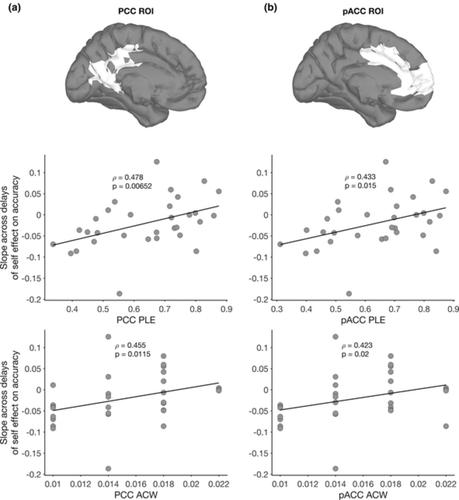当前位置:
X-MOL 学术
›
Hum. Brain Mapp.
›
论文详情
Our official English website, www.x-mol.net, welcomes your feedback! (Note: you will need to create a separate account there.)
Temporal integration as "common currency" of brain and self-scale-free activity in resting-state EEG correlates with temporal delay effects on self-relatedness.
Human Brain Mapping ( IF 4.8 ) Pub Date : 2020-07-22 , DOI: 10.1002/hbm.25129 Ivar R Kolvoort 1, 2 , Soren Wainio-Theberge 1 , Annemarie Wolff 1 , Georg Northoff 1
Human Brain Mapping ( IF 4.8 ) Pub Date : 2020-07-22 , DOI: 10.1002/hbm.25129 Ivar R Kolvoort 1, 2 , Soren Wainio-Theberge 1 , Annemarie Wolff 1 , Georg Northoff 1
Affiliation

|
The self is a multifaceted phenomenon that integrates information and experience across multiple time scales. How temporal integration on the psychological level of the self is related to temporal integration on the neuronal level remains unclear. To investigate temporal integration on the psychological level, we modified a well‐established self‐matching paradigm by inserting temporal delays. On the neuronal level, we indexed temporal integration in resting‐state EEG by two related measures of scale‐free dynamics, the power law exponent and autocorrelation window. We hypothesized that the previously established self‐prioritization effect, measured as decreased response times or increased accuracy for self‐related stimuli, would change with the insertion of different temporal delays between the paired stimuli, and that these changes would be related to temporal integration on the neuronal level. We found a significant self‐prioritization effect on accuracy in all conditions with delays, indicating stronger temporal integration of self‐related stimuli. Further, we observed a relationship between temporal integration on psychological and neuronal levels: higher degrees of neuronal integration, that is, higher power‐law exponent and longer autocorrelation window, during resting‐state EEG were related to a stronger increase in the self‐prioritization effect across longer temporal delays. We conclude that temporal integration on the neuronal level serves as a template for temporal integration of the self on the psychological level. Temporal integration can thus be conceived as the “common currency” of neuronal and psychological levels of self.
中文翻译:

时间整合作为大脑的“共同货币”和静息态脑电图的无自我标度活动与自我相关性的时间延迟效应相关。
自我是一个多层面的现象,整合了多个时间尺度的信息和经验。自我心理层面的时间整合与神经元层面的时间整合如何相关仍不清楚。为了研究心理层面上的时间整合,我们通过插入时间延迟来修改完善的自我匹配范式。在神经元水平上,我们通过无标度动力学的两个相关测量(幂律指数和自相关窗)对静息态脑电图的时间积分进行索引。我们假设,先前建立的自我优先效应(以自我相关刺激的响应时间减少或准确性增加来衡量)会随着成对刺激之间插入不同的时间延迟而改变,并且这些变化将与时间整合有关神经元水平。我们发现,在所有有延迟的情况下,自我优先对准确性都有显着影响,这表明自我相关刺激的时间整合更强。此外,我们观察到心理和神经元水平上的时间整合之间的关系:在静息状态脑电图期间,更高程度的神经元整合,即更高的幂律指数和更长的自相关窗口,与自我优先级的更强增加有关。跨较长时间延迟的效果。我们得出的结论是,神经元水平上的时间整合可以作为心理层面上自我时间整合的模板。因此,时间整合可以被视为自我神经元和心理层面的“共同货币”。
更新日期:2020-09-21
中文翻译:

时间整合作为大脑的“共同货币”和静息态脑电图的无自我标度活动与自我相关性的时间延迟效应相关。
自我是一个多层面的现象,整合了多个时间尺度的信息和经验。自我心理层面的时间整合与神经元层面的时间整合如何相关仍不清楚。为了研究心理层面上的时间整合,我们通过插入时间延迟来修改完善的自我匹配范式。在神经元水平上,我们通过无标度动力学的两个相关测量(幂律指数和自相关窗)对静息态脑电图的时间积分进行索引。我们假设,先前建立的自我优先效应(以自我相关刺激的响应时间减少或准确性增加来衡量)会随着成对刺激之间插入不同的时间延迟而改变,并且这些变化将与时间整合有关神经元水平。我们发现,在所有有延迟的情况下,自我优先对准确性都有显着影响,这表明自我相关刺激的时间整合更强。此外,我们观察到心理和神经元水平上的时间整合之间的关系:在静息状态脑电图期间,更高程度的神经元整合,即更高的幂律指数和更长的自相关窗口,与自我优先级的更强增加有关。跨较长时间延迟的效果。我们得出的结论是,神经元水平上的时间整合可以作为心理层面上自我时间整合的模板。因此,时间整合可以被视为自我神经元和心理层面的“共同货币”。



























 京公网安备 11010802027423号
京公网安备 11010802027423号